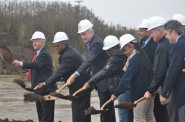How to Train Workers
Without the right training and opportunities for workers, the 30th Street Corridor will fail. Third story of a series.

Aerial view of the 30th Street Corridor. Photo courtesy of the Redevelopment Authority City of Milwaukee.
When once-dominant local companies like A.O. Smith and Tower Automotive closed down, they left behind more than empty buildings and brownfields. They also left behind a skilled workforce. “Tower and A.O. Smith, those weren’t basic factory jobs,” explains Gary Wenzel of Capitol Stamping, a company centrally located in the city’s 30th Street Corridor.
Tom Ryan, President of Jonco Industries, grew up on the South Side and remembers when there were so many companies hiring, workers could easily switch to other companies for better wages. As they moved from job to job, Ryan explains, those workers were also developing their skills. Alan Perlstein was the General Manager of DRS Technologies, a defense contractor located on the northern tip of the 30th Street Corridor, and recalls that the company “invested twenty million (dollars) in that plant because of the technical talent.”
Finding good workers is a challenge for any business, says Wenzel, and he thinks that companies who complain of the absence of skilled labor in Milwaukee are making excuses. “The people who work for us here truly appreciate working here,” he says. “I was not getting that same reaction when I was working in the suburbs.”
The workers that Wenzel can’t find are those who are highly skilled in traditional manufacturing. “A tool and dye maker who makes $25, $26, $27 an hour, we have a shortage,” he says. “I can’t find people who can set up a punch press anymore.” To solve that problem, Wenzel is building an on-site classroom and bringing in training programs from NovaTech and GPS Educational Partners. “It’s an investment,” he concedes, “but it’s our way of giving back to the community.” And it’s also a way of insuring he has skilled workers in the future. “If we can get 10 to 20 kids through that program a year, we’re building a workforce.”
GPS, according to its President Stephanie Borowski, sites its program within Milwaukee Public Schools and works with students who want to train for jobs in manufacturing. They take their regular classes, but also work in GPS classrooms where they have one teacher for 8-10 students. In their junior year, they begin a 21-month program in skills development that includes an on site apprenticeship with one of GPS’s business partners. Some are at-risk, or credit deficient, says Borowski, and “some are just discouraged, and some just want this experience.” The may go on to jobs in assembly line manufacturing, or may continue on with their education and move into IT, technical sales, or research development. Some of their students have even gone on to careers in engineering.
Darren Daniels, President of the Bishop’s Creek Development Corporation that runs workforce development programs, points out that workforce training often needs to begin at a very basic level. “You’ve got African American kids who are, quite frankly, out of the realm of science and technology,” he points out. They need technical skills, but they also need to develop the softer skills that will enable them to get hired and stay employed. Daniels supports workforce development at a solar installation company that he owns. Students start by learning how to install panels, but if they’re ready, they can move on to learn the technology — and this initiative, he adds, “spurred a coding curriculum that we do with UWM.”
Workers needs basic skills and advanced technical skills, but they also need training in entrepreneur and leadership skills, says Lee Menefee, of Uniting Garden Homes Inc., a neighborhood association in the corridor. Workers who have skills, but not knowledge of how to turn their skills into a career or into a business are always going to be vulnerable to layoffs. Jobs that start and stop, or jobs that are just part of a training program are not going to create the long-term sustainable gains in employment that the corridor needs. He estimates that workers in the area are 98 percent African American and he wants people to know that no one is asking for a handout, just the training that will enable workers to sustain long-term employment with companies that offer advancement opportunities. The revitalization of the corridor and of the city begins with the kinds of jobs that people can retire from. Once workers have some security, “housing follows and we think that safety follows.”
Companies that do business with the city have to comply with two preferential hiring programs: The Residential Preference Program requires that 40 percent of the hours worked on a project must be allocated to unemployed residents of the city. The city’s Small Business Enterprise program requires 25 percent of all dollars spent on construction go to firms owned by “one or more individuals who are at an educational, social, economic or other disadvantage.” But, those programs don’t guarantee long term viability, says Menefee. Companies have exploited the program in the past by taking the money and then meeting the requirements by hiring minority workers, but only into low-skilled, low-paying jobs that didn’t have the opportunities for advancement that were available to white employees. Those workers fail to thrive and continue to be vulnerable to layoffs.
“It’s not enough to have a good work ethic anymore,” says Kein Burton, the Redevelopment Authority of Milwaukee’s Development Manager for the 30th Street Corridor. Workers need to arrive with high-level skills to even get hired. And that training should focus not just on jobs in the corridor, but enable that worker to go anywhere where jobs are available. “It’s just fair,” she says.
Even with all these efforts, in which his company Jonco Industries participates, Ryan is still worried about those workers who may not succeed in high-level skills training, whether it’s because they just don’t have the ability, or they’ve been too deeply impacted by the ravages of poverty that currently plague the corridor. “We have the entry-level kid, who, because of his family, is going to have all the chance in the world.” Maybe 25 to 75 percent of the kids in those programs have a chance, he estimates, but what about the one to 30 percent who “have no chance?” How much of that problem is environmentally induced, he wonders, and what can be done for those workers who get left behind? “Those are still good people,” he says. “Those are great people.”
The answer might lie with businesses like United Milwaukee Scrap. Art Arnstein remembers when the neighborhoods of the corridor were vibrant places to live, full of opportunity. And he wonders: Is the city’s focus on advanced manufacturing so pointed that it’s going to leave out the kinds of employers who have jobs that need more basic skills, like his company? Gloria Stearns, who works with the corridor’s Business Improvement District, points out that businesses like Arnstein’s are an asset to the corridor because they provide jobs and benefits for workers who don’t, and may never, have the skills to go elsewhere. Stearns and Arnstein would argue that the corridor will be a success only if it creates opportunities for all workers, not just the high skilled ones.
“In the long run,” says Arnstein, “those families want the same thing for their families that everyone wants for their families. They want good schools for their kids. They want to take their kids to a show. They want to take their kids to a restaurant, but they need a good paying job to do that.”
Corridor of Dreams
-
How to Design a Public Space
 Jun 26th, 2015 by Susan Nusser
Jun 26th, 2015 by Susan Nusser
-
Celebrating the First Homeowner in New Program
 Oct 24th, 2014 by Susan Nusser
Oct 24th, 2014 by Susan Nusser
-
Putting the Pieces Together
 Oct 17th, 2014 by Susan Nusser
Oct 17th, 2014 by Susan Nusser




















